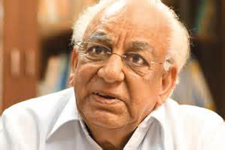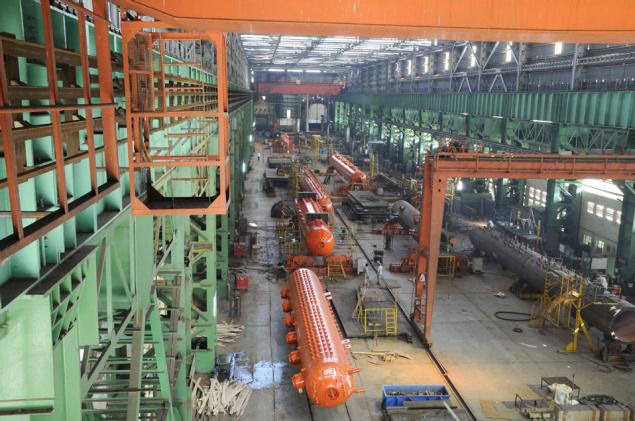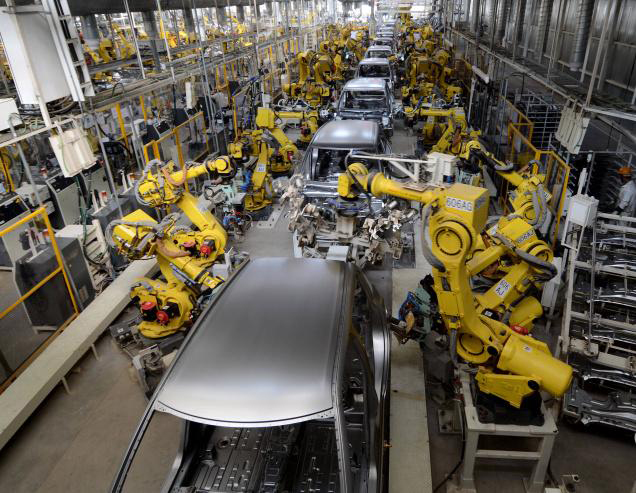|
V Krishnamurthy’s At The Helm – A Memoir traces his tenure at the top of three major corporates – Maruti, BHEL and SAIL. He narrates in detail his steering these companies to great success and his charting new �management concepts.

V. Krishnamurthy.
It was just after the launch of Industrial Economist in March 1968 that we carried in its ‘Glimpses’ column a short note on BHEL-Tiruchi. We wondered why the sprawling unit, manufacturing industrial boilers, had failed to win an order from Madras Fertilizers Ltd. Within days, I received a two-page letter, which provided an outline of the issue. The writer invited me to visit the temple town and have a look at the �facilities. One V. Krishna�murthy (VK) had signed it. He was the Company’s General Manager.
When I visited the production facilities a week later, I was deeply impressed with the passion and involvement of the workforce and their ability to produce sophisticated equipment to strict time schedules. What impressed me most was BHEL-T winning an order for boilers from Malaysia – three years before the first BHEL boiler was fired at the Ennore thermal station!
My fascination for BHEL, which started in 1968, has continued through these past 46 years during which I have visited the various plants of BHEL in different parts of India and the several sites where BHEL equipment was installed and had been operating effectively. The visits to Tiruchi have been like pilgrimages undertaken at least once a year to keep myself updated on the expansion of facilities and to report on the progress.
I had expressed my amazement on the utilisation levels of equipment supplied by Czechoslovakia on identical terms and comparable costs at two different plants – one at Tiruchi and the other at the Bharat Heavy Plate and Vessels Ltd. (BHPV) at Visakhapatnam. While the former has grown into a highly sophisticated plant that acco�unts for a turnover of over Rs. 15,000 crore, the BHPV plant, attached to the Ministry of Fertilisers, did not do well, turned sick and was later taken over by BHEL. While BHEL-T expanded output manifold by path-breaking development of ancillary industrial units and constantly upgraded technology through collaborations, BHPV declined.

BHEL.
In 1972, VK successfully convinced policymakers in Delhi to merge the much older Heavy Electricals (India) Ltd with BHEL and form a single large power equipment manufacturer, BHEL. It was a herculean task bringing about a synthesis of cultures of the two different units. The initial doubts and resistance by senior managers were tackled by �making them work in much higher positions at the different plants.
In quick time BHEL emerg�ed a leader not just in the field of power equipment manufacture but also in the public �sector. I remember the vibrant media campaign of BHEL designed by R.K. Swamy of HTA to highlight the commanding heights reached by the public sector. Particularly fascinating was the record of the giant �company to expand its range of products by ramping up the �capacities of the individual plants in different parts of the country.
The best proof for the success of BHEL through the 1970s was the ability of the Company to supply top talent for high managerial positions. From the earlier practice of such talent being largely supplied by multinationals like Hindustan Unilever, ITC and the Indian Railways, from the 1970s we witnessed BHEL supplying chief executives both for the public sector and for private enterprises!

Maruti.
In 1977, I was in Delhi around the time when VK was appointed Secretary in the �Department of Heavy Industry. When I dropped in to offer my congratulations, he suggested my visiting Hyderabad to see the facilities there. I joined VK and other directors on the flight to Hyderabad and we went to Ramachandrapuram. Over time, the Hyderabad unit has taken up a spectacular diversification: new product lines for manufacture of oil rigs to meet the requirements of ONGC at Bombay High, which was then reaching peak production, and a vast range of industrial equipment and switch gears were �introduced. A separate �division was also set up for R&D.
The waning success of BHEL for several years post-1970s, when both VK and S.V.S. Raghavan left, was marked by this giant corporation losing its prestige and clout. We witnessed a re-bound only during the boom years in the new millennium. The UPA I government gave high priority for power development. BHEL was ready to grab the opportunity and in quick time became once again a true leader in the public sector.
* * *

SAIL.
Prime Minister Indira Gandhi then requested VK to build the Maruti factory in the aftermath of Sanjay Gandhi’s death. VK describes in great detail the initial challenging years at Maruti. He held to his promise on delivering the first vehicle by the end of 1983, within less than three years of taking charge.
I met him in 1984 and asked how he was confident that the market would be able to absorb 100,000 cars at a time when �total size of the market, fed by three Indian manufacturers was just around 40,000. VK’s �reasoning was grand: “The Maruti 800 is a state-of-the-art product. It promises a saving of Rs. 1000 per month on maintenance. Thus, in four years the saving will be around Rs. 48,000, which is more than the initial price announced of Rs. 47,000. Thus, every buyer of Maruti can easily go for a �replacement through the sheer savings involved!”
Maruti’s success is a marvellous story by itself, worthy of a global case study. It marked a Hanuman jump over obsolete technology adopted by the exiting manufacturers, Hindustan Motors, Premier Automobiles and Standard Motors, who were also beset with low volumes of production and restrictions on capacity. VK describes the phenomenal care bestowed by him in selecting the collaborator, his top management team and in quietly adopting several of the salutary practices he had introduced in BHEL.
The advent of Maruti was a watershed in upgrading not just production technology in the engineering sector but in the introduction of a vast new work culture. These were later �ada�pted to great profit by �hundreds of manufacturing concerns.
Of course, there was no dearth of sceptics. I remember my discussions with a few �captains of industry involved in the manufacture of automobiles and components in Madras. They were content with the volume of business offered by Telco (Tata Motors) and were not quite impressed with the promise of Maruti to raise �production to 100,000 cars in quick time. But once VK �established the capability to walk his talk, they rushed to register with Maruti as suppliers.
It was not just an engineering marvel; it was financial �engineering at its very best. In the initial years, Maruti opened bookings requiring a deposit of Rs. 10,000 per car for registration and adopted a system of �allotment that was transparent. The first bout of registrations saw the Company garnering Rs. 130 crore by way of deposits. The Company paid seven per cent interest to the depositors. The second bout garnered another Rs. 140 crore. The opening for Omni received an equal sum and when Maruti �announced bookings for its 1000 cc car there was a mad scram�ble. Many borrowed money from the banks to deposit the initial fee of Rs. 25,000 to avail of profits on re-sale of such vehicles, if allotted. The bookings were for a massive 250,000! This helped the Company garner around Rs. 625 crore! The Company lent this money to other public sector undertakings at an interest of 15 per cent per annum. In the initial years, Maruti earned more income through this financial engineering than from car sales!
There was disbelief over the phenomenal success of Maruti under the stewardship of VK. The ability to raise production to 100,000, ensure of quality and reliability, and to assure low maintenance costs and comfortable driving �had �resulted from the country catching up with state-of-the-art technology and management. Maruti set the standard for �production, sales and �service.
* * *
VK’s assuming charge as Chairman of SAIL in 1985 at the behest of Prime Minister Rajiv Gandhi posed him his most difficult challenge. In the case of BHEL and Maruti he had the advantage of building these from scratch and experimenting with many new �concepts. At SAIL, a well-�established company, it was not that simple. At the time he took charge, SAIL was suffering from low productivity, high costs, poor quality, little customer �orientation and low morale of the workforce. VK describes in detail how he took great pains to interact with groups of the large workforce which, at that time, was in the region of 240,000, spread over several plants in different parts of India. He had to take tough decisions. The most sensitive of these �related to his bold announcement that there would not be any overtime. Unlike in BHEL and Maruti, VK had to contend with a very large number of trade unions, which were very strong, especially in Durgapur.
In the five years he was at the helm at SAIL, he transformed the company into one that increased productivity manifold. There was a huge �focus on quality, and customer orientation was brought about for the first time. I consider the transformation of SAIL as among the high points of VK’s tenure at the helm of three �major companies.
In At the Helm – A Memoir, V. Krishnamurthy describes in detail his approach to industrial organi�sation and management. For three decades, from the 1960s, VK strode the industrial map of India like a colossus. The country owes him a great deal for the enormous contribution he made during this period.
His very rich experience, was, again, put to good use by the UPA government. As �Cha�ir�man of the National Manu�facturing Competitiveness Coun�cil, VK brought into focus the manufacturing sector.
His memoir provides deep insights into the evolution of several manufacturing practices. The most significant part of this relates to the evolution of the Indian work ethic. VK �almost single-handedly esta�blished the Indian model of management, laying great emphasis on communication with the workforce and establishing the capability of the public �sector chiefs to manage large enterprises effectively. – (Courtesy: Industrial Economist)
* * *
|

